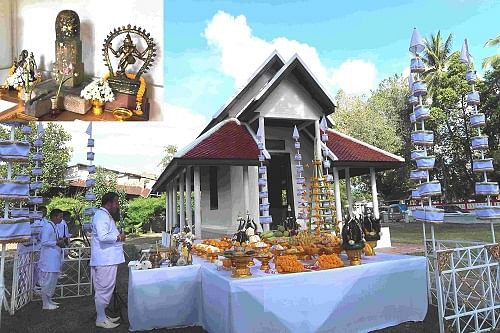
Songkran, the Thai New Year, is one of the largest festivals in South-East Asia. It is observed on April 13 every year and typically holidays extend to three more days. While water fighting is the most obvious attraction for the youth, merit-making by bathing Buddha images in water is an essential ceremony of Songkran.
Only in the city of Nakhon Si Thammarat in southern Thailand, during these holidays people honour the Hindu god Shiva for bringing peace and happiness to the kingdom by celebrating the Nang Kradan festival. This unique Hindu festival is organised by the majority Buddhist population to commemorate shared cultural heritage with the dwindling Hindu communities.
Since the early centuries of AD, ships serving maritime trade routes connecting the Mediterranean, Arabia, India and China brought traders to southern Thailand. Along with Indian traders, ships brought Indian artisans, Buddhist monks and Hindu Brahmin priests. They predominantly came from southern India and spoke Tamil. From India, they brought the knowledge of the language, art, religion, statehood, Ayurveda, tool-making and agriculture with them which transformed the societies.
Several stone inscriptions written in Pallava script and Hindu deities found in Nakhon Si Thammarat suggest that Indians began to settle down in southern Thailand in the seventh century AD or earlier. Artistic styles of many iconic Buddhist and Hindu artefacts of southern Thailand strongly attest their connections to Indian art styles of the periods such as Pallava and Chola.
In the cultural fabric of southern Thailand, Hindu practices were handed down over many generations and Thai kings were known to commission Brahmin priests for certain ceremonies. Even today, during Thai festivals, an ordained Brahmin priest is easily recognisable from his hair bun, white long-sleeved shirt, Thai trouser, white stockings and white shoes.
Only a handful of Brahmin families remained in Nakhon Si Thammarat while others moved to Bangkok to serve the kingdom’s Royal court. On the morning of Nang Kradan festival, Ho Phra Isuan, a renovated Shiva shrine of the Ayutthaya period, where many Hindu artefacts were found, becomes the site of worship for the members of Brahmin families from the entire province.
At dusk, Phra Sayom base, the ancient Shiva shrine is the site where the Nang Kradan parade starts before it reaches the Sanam Na Muang Park for the evening open-air cultural show that attracts thousands of spectators.
Nang Kradan signifies three carved and painted wooden planks that depict the sun (Phra Surya), the moon (Phra Ratchaneekron), the earth goddess (Phra Thoranee) and the river goddess (Phra Kangka / Ganges). These are blessed in Phra Sayom ancient Shiva shrine and then carried in palanquins amid traditional live music and a candlelight procession.
For the evening gala, local artistes dress in traditional Thai attires and jewellery to showcase various dance performances.
A short movie presents the glorious history of Nakhon Si Thammarat and its place in Thai history.
The evening celebration ends with a spectacular light and sound show that presents Shiva’s visit to the earth in which a giant swing plays an important role that has its root in the Triyampavai-Tripavai swing ceremony of the past.
Nakhon Si Thammarat’s tourism department, government officials, artistes and volunteers deserve appreciation for their support and participation to keep this centuries-old tradition alive.